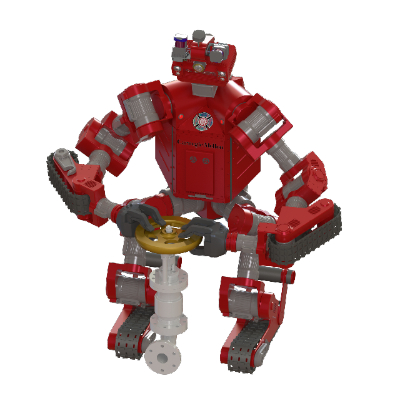
Getting a Grip on Industrial Assembly Lines
By Treena Hein
Automation Motion Control Machine Building DARPA Robotics RobotiqQuebec’s Robotiq looks to achieve intelligent and super-agile gripping as robots are asked to accomplish increasingly complex tasks.

Quebec-based Robotiq’s intelligent 3-finger Adaptive Robot Grippers mimic the flexibility and agility of human hands.
“For the past two decades, robot-makers have been working hard to create efficient bin picking systems, and we are getting very close now,” says the president of St-Nicolas, Quebec-based Robotiq (pronounced Ro-bah-teek). “While the automation of many different production processes has progressed quite quickly, it’s still been necessary to keep people doing highly repetitive tasks such as sorting parts.”
But with the progress being made with 3D vision systems, computation and flexible end-effectors, Bouchard says, “I believe highly-efficient bin sorting will soon be a reality for today’s industrial production lines.”
It’s in those highly agile and flexible end-effectors that Robotiq specializes. Founded in 2008, the company embeds mechanical intelligence into their universal gripping devices to boost the overall efficiency of automated systems. Bouchard started the company because he saw a large gap between robotics research and the robotics industry.
“I knew the lab we were in during my grad work at Laval University had something of value for the industry,” he says. “The two other Robotiq co-founders [Jean-Philippe Jobin and Vincent Duchaine] and I looked at several technologies and chose to develop better robot hand technology because we could find good applications for it, and the technology was mature.”
The Robotiq team set to work to create the company’s standard offerings – the Robotiq 2-Finger and 3-Finger universal electric ‘Adaptive Robot Grippers’ – which are able to grip objects of any shape. After the grip has occurred and a motion is executed, the devices are also able to monitor whether they still have the object.
“We tried to keep the system as simple as possible,” says Bouchard. “It has to be holistic too. In order to have a good control, the mechanics, electronics and software really have to be developed together.”
Robotiq Grippers employ a combination of motor current monitoring and encoder data to detect pick-up. “The Gripper respects the incremental encoder value feedback relating to opening and closing limits, and cycle time is thus reduced because it doesn’t have to fully open or close,” Bouchard explains. “This is much more flexible than pneumatic grippers, which operate only from fully open to fully closed and also therefore take up more space and have limited stroke around small parts.”
Motor current is another feedback source. By knowing it, power supplies and their related protection devices can be appropriately dimensioned. “It can be used in a qualitative way to know what final force will be applied by the fingers to the object,” Bouchard explains. The 2-Finger Gripper also has an auto-locking mechanism, so that the motor doesn’t need to apply force continuously on an object to maintain the desired final force. This is for safety reasons and to reduce the amount of power required once an item is picked up.
But although these Grippers can accomplish so much, efficient bin picking has yet to be achieved. “It’s because there are often so many geometry types on each part to consider for proper handling in an industrial setting,” Bouchard says. “Parts are also in a random and unstructured environment so vision systems have to be very precise, and the computation behind the system has to be able to make sense of all the data detected by the vision system. Then, the robot has to be equipped with effective and flexible end-effectors to be able to handle the parts in many different ways. So all three pillars have to be in place.”
He says the progress that’s been made with vision systems over the past decade has been impressive, but they still have some way to go. “Computation is an even larger challenge and remains the major issue with bin picking,” he says. “Being able to calculate 1D linear segments, 2D features or 3D scenes was feasible, but making sense of all this data is a significant task.”
Achieving a flexible end-effector has involved various approaches. “Vacuum cups are an option, but they don’t work well when parts are irregular or there’s not enough flat spots to achieve a good grip,” notes Bouchard. “Pneumatic grippers are another possibility. You can control the force of the grip by controlling the pressure, but it’s hardly programmable. There is no built-in grip detection, only limited speed control and it’s also hard to achieve low force levels.”
The development of electric grippers has opened up a new world because the speed, force and position of the fingers are all adjustable. “So our grippers give more options to the computation software by being able to pick a part from different orientations,” Bouchard notes, “but better vision and computation systems are needed to achieve highly-efficient bin sorting.”

Robotiq’s Adaptive Gripper is a key component of Carnegie Mellon University’s CHIMP robot, a leading entry in DARPA’s Robotics Challenge.
Robotiq’s 3-Finger Gripper is heading to the next DARPA (Defense Advanced Research Project Agency) Robotics Challenge as part of the Carnegie Mellon University (CMU) entry, CHIMP. In this challenge, robots have to perform complex decision-making tasks in disaster scenarios. Bouchard says the CMU team benchmarked several robotic hands available and found that Robotiq’s was a good fit for their design approach. Being part of this competition is a great source of pride for Robotiq team. “We also believe the Challenge will provide us with great visibility and demonstrate innovative ways to use our grippers,” Bouchard says, “no matter the outcome.”
DARPA win or not, Bouchard’s enthusiasm for robotics isn’t likely to ever flag. “I like the fact that it combines many disciplines and can be applied in various industries,” he says. “We’re just scratching the surface of what robots can do.”
http://robotiq.com/en
